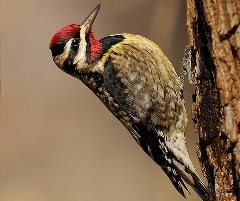Bloodroot is one of our favorite spring flowers. Each plant blooms only briefly, and there's a window of only a few weeks that the bloodroots bloom at all. It's one more thing that inspires us to spend as much time as possible in the woods at this time of year.
Every year we look for the cheery flowers of the
spicebush as they emerge to light up the understory. It's common throughout our local forests.
Photo credit: jpwbee
Spring peepers are another pilgrimage-inspiring phenomenon in our household. How are these tiny critters so LOUD? And why are they so hard to find? Last spring we finally figured out how to spot them.
The frogs are noisy because they're looking to mate. Spring peepers lay their eggs in out-of-the-way places, but we often find wood frog eggs in March, easily visible in vernal ponds in many of the local parks.
Spring Beauties are not a showy flower, but we find them dainty and adorable. They're one of the first spring ephemerals: perennial flowers that emerge every spring on the forest floor, and they last a little longer than most.
Bittercress is less adorable, but more abundant than spring beauties -- and edible! Throw some in your spring salad mix for a vitamin-packed punch.
I love to watch yellow-bellied sapsuckers as they feed: they make a series of round holes in a tree's bark, then lap up the sap that comes out -- and the insects that are attracted to it. The yellow-bellied sapsucker is considered a "keystone" species by some ecologists because so many other birds rely on them, following along for their leftovers.
As the sapsuckers are coming to town, the Canada Geese are leaving. We've seen several flocks over the last few days.
Woodcocks are much harder to spot, but they'll put on even more of a show than the sapsuckers and the geese, if you can find them.
Want more? See also the list of things we found on a walk we took in mid-March a couple of years ago.


